Date: 7/2/07
Product Description: Oil Filters
Subject: Correlation between particle size and engine wear.
OBJECTIVE:
Provide information regarding the relationship between contaminant particle size and engine wear.
ISSUES:
The value of superior filtration is often underestimated. Removal of contaminants ranging in size from 2 to 22 microns (μ) is key to ensuring maximum filtration protection.
TECHNICAL DISCUSSION:
Some Contaminants Cause More Damage
The level of damage particles cause to an engine is directly
related to the size of the particles. The oil stream within the engine flows
between wear sensitive surfaces that usually have clearances between 2 and 22
microns. It is contaminants in this size range that pose the greatest threat as
they can slip between moving components, causing a great deal of wear. To
appreciate how small these particles are, one must first understand the
measurements involved in their classification. A micron, or micrometer (μ),
is a very small unit of linear measurement. 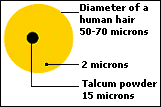 One micron is equal to one millionth
of a meter, and 25 microns is equal to 0.001 inch. To better put this in
perspective, consider that the diameter of a human hair is 50-70 microns. Large
particles are particles measuring 1/2" or
larger. They pose little threat to engines because they are easily removed by
the air filter. Medium particles are particles measuring 25μ to
1/2". While they are of greater
concern than large particles because they are more difficult to remove, the
threat they pose is diminished since hey are still larger than many of the
clearances within an engine. Their size will not allow them to enter the contact
areas between many components to promote accelerated wear. Small
particles are particles measuring between 5
and 25μ. Small particles are of greatest concern because they can penetrate
the clearances between wear-sensitive components and promote accelerated wear.
And, because they are so small, they are difficult to remove from the oil
stream.
One micron is equal to one millionth
of a meter, and 25 microns is equal to 0.001 inch. To better put this in
perspective, consider that the diameter of a human hair is 50-70 microns. Large
particles are particles measuring 1/2" or
larger. They pose little threat to engines because they are easily removed by
the air filter. Medium particles are particles measuring 25μ to
1/2". While they are of greater
concern than large particles because they are more difficult to remove, the
threat they pose is diminished since hey are still larger than many of the
clearances within an engine. Their size will not allow them to enter the contact
areas between many components to promote accelerated wear. Small
particles are particles measuring between 5
and 25μ. Small particles are of greatest concern because they can penetrate
the clearances between wear-sensitive components and promote accelerated wear.
And, because they are so small, they are difficult to remove from the oil
stream.
SAE Testing
In the 1988 Correlating Lube Oil Filtration Efficiencies With Engine Wear technical paper published by the Society of Automotive Engineers (SAE), the relationship between filtration levels and abrasive engine wear was established. Testing determined that wear was reduced by as much as 70 percent by switching from a 40μ filter to a 15μ filter. The SAE conducted tests on a heavy-duty diesel engine and an automotive gasoline engine, and both provided consistent results.
New Technology Provides New Options
The SAE paper on filtration discusses the introduction of synthetic fibers into the oil filter market, which offer "the capability of achieving high levels of filtration without the traditional sacrifice of dirt holding capacity and increased flow restriction." Today, a new pinnacle has been reached with synthetic nanofiber technology and AMSOIL Ea Oil Filters. While today's filters offer even greater performance, the message then was the same as it is now; removal of particles measuring 2 to 25μ is the key to controlling engine wear, and there is a direct correlation between oil filter efficiency and engine wear.
Test Results
To establish a relationship between levels of filtration and engine wear rates, the SAE used a variety of oil filter types in its tests. Three glass filters and one traditional cellulose-media filter were used in the diesel tests, while one cellulose, one glass and two glass/cellulose-blend filters were used in the gasoline engine tests. The micron rating of each oil filter was determined, and testing was conducted according to SAE guidelines.
The Filter Particle Retention Curves chart that follows shows the particle retention for each filter tested. The filters were tested at their 98 percent efficiency point and their single pass efficiency curves were determined by comparing the number of particles upstream from the filter with the number of particles downstream. The Engine Wear Rates charts demonstrate the correlation between superior filtration and reduced engine wear. The filters that provided superior efficiency also provided superior engine protection.
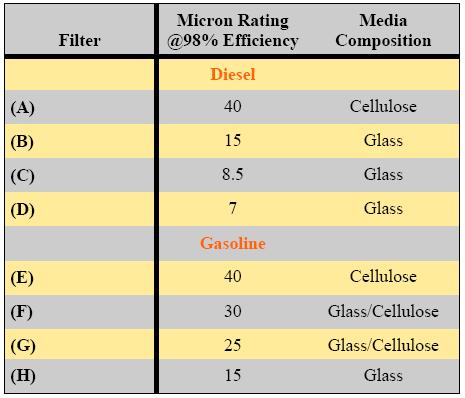 |
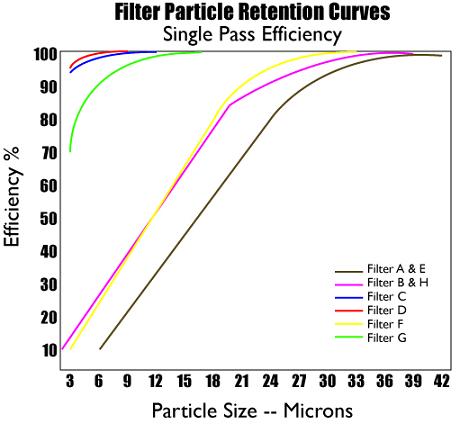 |
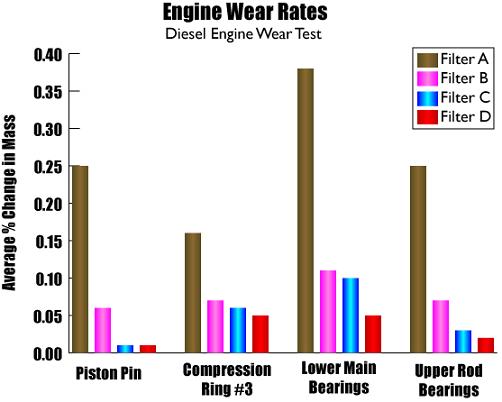 |
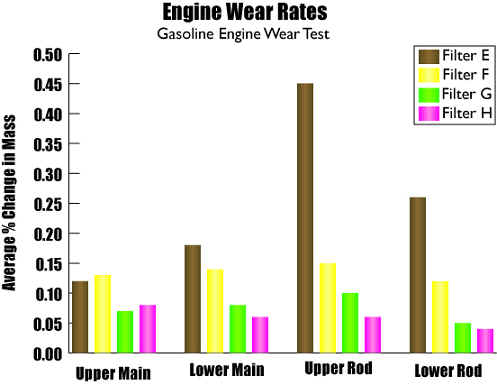 |
Conclusions
The SAE paper summarizes the test results with the following conclusions: "Abrasive engine wear can be substantially reduced with an increase in filter single pass efficiency. Compared to a 40μ filter, engine wear was reduced by 50% with 30μ filtration. Likewise, wear was reduced by 70% with 15μ filtration. Controlling the abrasive contaminants in the range of 2 to 22μ in the lube oil is necessary for controlling engine wear. The micron rating of a filter, as established in a single pass efficiency type test, does an excellent job in indicating the filter's ability to remove abrasive particles in the engine lube oil system."
RECOMMENDATION:
Ea Oil Filters have been evaluated using today's benchmark test, the ISO 4548-12 multi-pass test. AMSOIL Ea Oil Filters provide 98.7 percent efficiency at 15μ and up to 70 percent efficiency at 7μ. Competitive filters range from approximately 85 to 92 percent efficiency at 15μ. When it comes to removing contaminants in the most critical size range (2 to 22μ), AMSOIL Ea Filters greatly outperform competitive filters.
Summary
Even with all of the advances in lubrication and engine technology, filtration is as important today as it ever was. The combustion process produces by-products that slip into the oil stream, and external contaminants are introduced into the engine in a variety of ways. The challenge for filter manufacturers is balancing flow, efficiency and filter life. In order to stop particles in the 2 to 22μ range, the pores in the cellulose media used in many filters are too small to allow adequate oil flow.
AMSOIL Ea Oil and Air Filters feature full synthetic nanofiber technology. It is the nanofibers that allow Ea Filters to provide greater efficiency than any other filter available. Ea Filters stop more particles, stop smaller particles and last longer than any other oil filter available for auto/light truck applications.
References
(1) Staley, David R. "Correlating Lube Oil Filtration Efficiencies with Engine Wear," SAE 881825
Report problems to Webmaster